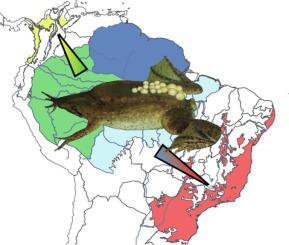Molecular Phylogenetics and Evolution ( IF 3.6 ) Pub Date : 2022-02-19 , DOI: 10.1016/j.ympev.2022.107442 Antoine Fouquet 1 , Josselin Cornuault 2 , Miguel T Rodrigues 3 , Fernanda P Werneck 4 , Tomas Hrbek 5 , Andrés R Acosta-Galvis 6 , David Massemin 7 , Philippe J R Kok 8 , Raffael Ernst 9

|
The genus Pipa is a species-poor clade of Neotropical frogs and one of the most bizarre-looking due to many highly derived anatomical traits related to their fully aquatic lifestyle. With their African relatives, they form the Pipidae family, which has attracted much attention, especially regarding its anatomy, reproductive biology, paleontology and biogeography. However, the actual diversity and phylogenetic relationships within Pipa remain poorly understood, and thus so do their historical biogeography and the evolution of striking features, such as the absence of teeth and endotrophy in some species. Using short mtDNA sequences across the distribution of the genus, we identified 15 main lineages (Operational Taxonomic Units - OTUs). This more than doubles the number of the currently seven valid nominal species. Several closely related OTUs do not share nuDNA alleles, confirming species divergence. Time-calibrated phylogenies obtained from mitogenomes and from 10 nuclear loci provide highly similar topologies but strikingly distinct node ages for Pipa. High dN/dS ratios and the variation of substitution rates across the trees suggest a strong effect of saturation on fast evolving positions of mtDNA, producing a substantially shorter stem branch of Pipa. Focusing on the nuDNA topology, we inferred an early Neogene Amazonian origin of the diversification of Pipa, with an initial split between the Guiana-Brazilian Shields and Western Amazonia, a pattern observed in many other co-distributed groups. All the western species are edentate, suggesting a single loss in the genus. Each of these groups diversified further out of Amazonia, toward the Atlantic Forest and toward trans-Andean forests, respectively. These events are concomitant with paleogeographic changes and match patterns observed in other co-distributed taxonomic groups. The two Amazonian lineages have probably independently acquired endotrophic larval development.
中文翻译:

琵琶属的多样性、生物地理学和生殖进化(两栖动物:无尾:琵琶科)
琵琶属是新热带青蛙的一个物种贫乏的进化枝,由于与它们完全水生的生活方式有关的许多高度衍生的解剖特征,它是最奇怪的进化枝之一。它们与非洲近亲组成了鼹鼠科,尤其是在其解剖学、生殖生物学、古生物学和生物地理学方面备受关注。然而,琵琶内部的实际多样性和系统发育关系仍然知之甚少,因此对它们的历史生物地理学和显着特征的进化也知之甚少,例如某些物种没有牙齿和内养。使用跨越该属分布的短 mtDNA 序列,我们确定了 15 个主要谱系(操作分类单位 - OTU)。这使当前七个有效的标称物种的数量增加了一倍多。几个密切相关的 OTU 不共享 nuDNA 等位基因,证实了物种差异。从有丝分裂基因组和 10 个核位点获得的经过时间校准的系统发育为琵琶提供了高度相似但明显不同的节点年龄. 高 dN/dS 比率和跨树替代率的变化表明,饱和度对 mtDNA 快速演变的位置有很强的影响,从而产生了明显更短的琵琶茎枝。着眼于 nuDNA 拓扑结构,我们推断出琵琶多样化的早期新近纪亚马逊起源,在圭亚那-巴西盾和西部亚马逊之间最初分裂,这是在许多其他共同分布的群体中观察到的模式。所有西方物种都是无齿的,表明该属有单一损失。这些群体中的每一个都进一步从亚马逊流域向大西洋森林和跨-分别是安第斯森林。这些事件伴随着在其他共同分布的分类群中观察到的古地理变化和匹配模式。这两个亚马逊血统可能独立地获得了内养幼虫的发育。













































 京公网安备 11010802027423号
京公网安备 11010802027423号